A Palestinian Legislative Council was established by the Egyptian government in the Gaza Strip in 1962, which lasted until it was disbanded by the Israeli authorities in 1967. The Council replaced the All-Palestine National Council, disbanded several years earlier.
In 1957, the Basic Law of Gaza established a Palestinian Legislative Council that could pass laws which were given to the High Administrator-General for approval. [1]
This was done as part of the policy of Egyptian president Gamal Abdel Nasser of showing support for the Palestinian cause. The legislative council had 22 elected members in 1962, when elections were held.
The Council building was destroyed on Wednesday 15 November 2023 during an Israeli air strike during the Israeli response to the Al-Aqsa Flood operation. [2]

The Gaza Strip, or simply Gaza, is a polity and the smaller of the two Palestinian territories. On the eastern coast of the Mediterranean Sea, Gaza is bordered by Egypt on the southwest and Israel on the east and north.
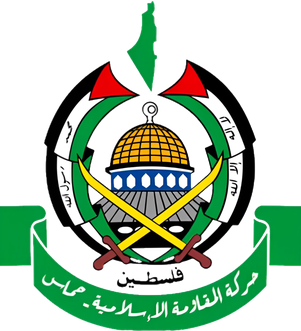
Hamas, an acronym of its official name, Harakat al-Muqawama al-Islamiya, is a Palestinian Sunni Islamist political and military movement governing parts of the occupied Gaza Strip.
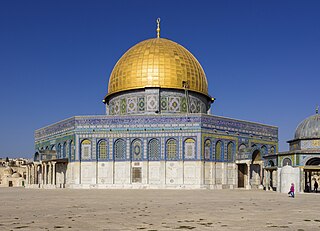
The history of the State of Palestine describes the creation and evolution of the State of Palestine in the West Bank and Gaza Strip.

The Palestinian territories are the two regions of the former British Mandate for Palestine that have been occupied by Israel since the Six-Day War of 1967, namely the West Bank and the Gaza Strip. The International Court of Justice (ICJ) has referred to the West Bank, including East Jerusalem, as "the Occupied Palestinian Territory", and this term was used as the legal definition by the ICJ in its advisory opinion of July 2004. The term occupied Palestinian territory was used by the United Nations and other international organizations between October 1999 and December 2012 to refer to areas controlled by the Palestinian National Authority, but from 2012, when Palestine was admitted as one of its non-member observer states, the United Nations started using exclusively the name State of Palestine. The European Union (EU) also uses the term "occupied Palestinian territory". The government of Israel and its supporters use the label "disputed territories" instead.
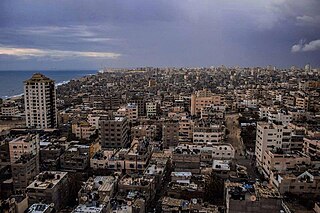
Khan Yunis is a city in the southern Gaza Strip; it is the capital of the Khan Yunis Governorate in the Gaza Strip. According to the Palestinian Central Bureau of Statistics, Khan Yunis had a population of 205,125 in 2017. Khan Yunis, which lies only four kilometres east of the Mediterranean Sea, has a semi-arid climate with temperature of 30 °C maximum in summer and 10 °C minimum in winter, with an annual rainfall of approximately 260 mm (10.2 in).

Palestine, officially the State of Palestine, is a state in the Southern Levant region of West Asia. Founded on 15 November 1988 and officially governed by the Palestine Liberation Organization (PLO), it claims the West Bank and the Gaza Strip as its territory, all of which has been Israeli-occupied territories since the 1967 Six-Day War. The West Bank contains 165 Palestinian enclaves that are under partial Palestinian rule, but the remainder, including 200 Israeli settlements, is under full Israeli control. The Gaza Strip was governed by Egypt but conquered by Israel in 1967. Israel governed the region until it withdrew in 2005; although it is still considered to occupy Gaza. Hamas seized power after winning the 2006 Palestinian legislative election. The Gaza Strip has since been blockaded by Israel and Egypt.
Abdel Aziz al-Rantisi was a Palestinian political leader and co-founder of Hamas, along with Sheikh Ahmed Yassin.
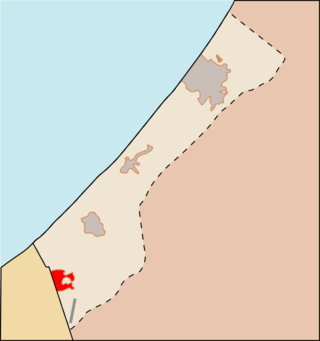
Rafah is a Palestinian city in the southern Gaza Strip; it is the capital of the Rafah Governorate, located 30 kilometers (19 mi) south-west of Gaza City. In 2017, Rafah had a population of 171,889. As a result of massive bombardment and ground assaults in Gaza City and Khan Yunis by Israel during the Israel–Hamas war, about 1.65 million people are believed to be sheltering in Rafah.

The 1949 Armistice Agreements, which ended the 1948 Arab–Israeli War by delineating the Green Line as the legal boundary between Israel and the Arab countries, left the Kingdom of Egypt in control of a small swath of territory that it had captured and occupied in the former British Mandate for Palestine: the Gaza Strip. This period saw the creation of the All-Palestine Government within the All-Palestine Protectorate, an Egyptian client state that would last until 1959, a year after the Republic of Egypt and the Second Syrian Republic merged to form a single sovereign state known as the United Arab Republic. The Egyptian occupation of the Gaza Strip was briefly subsumed by Israel during the 1956 Suez Crisis and ended entirely during the 1967 Arab–Israeli War, after which the Israeli Military Governorate was established in the territory and succeeded by the Israeli Civil Administration in 1981; the direct Israeli presence in the Gaza Strip ended with the 2005 disengagement plan.
The Arab League was formed in Cairo on 22 March 1945 with six members: Egypt, Iraq, Transjordan, Lebanon, Saudi Arabia, and Syria. Yemen joined on 5 May 1945. Since its formation the Arab League has promoted the Palestinian Arab cause in the Israeli–Palestinian conflict, including by imposing the Arab League boycott of Israel. The Arab League opposed the United Nations Partition Plan for Palestine in 1947. On 15 May 1948, the then seven Arab League members coordinated an invasion of what was by then the former British Mandate, marking the start of the 1948 Arab–Israeli War.
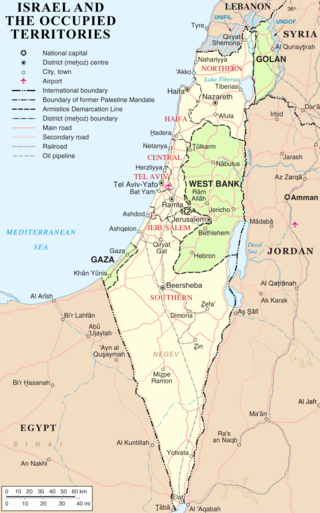
Israel has occupied the Palestinian territories and the Golan Heights since the Six-Day War of 1967. It previously occupied the Sinai Peninsula and southern Lebanon as well. Prior to Israel's victory in the Six-Day War, occupation of the Palestinian territories was split between Egypt and Jordan, with the former having occupied the Gaza Strip and the latter having annexed the West Bank; the Sinai Peninsula and the Golan Heights were under the sovereignty of Egypt and Syria, respectively. The first conjoined usage of the terms "occupied" and "territories" with regard to Israel was in United Nations Security Council Resolution 242, which was drafted in the aftermath of the Six-Day War and called for: "the establishment of a just and lasting peace in the Middle East" to be achieved by "the application of both the following principles: ... Withdrawal of Israeli armed forces from territories occupied in the recent conflict ... Termination of all claims or states of belligerency and respect for and acknowledgment of the sovereignty, territorial integrity and political independence of every State in the area and their right to live in peace within secure and recognized boundaries free from threats or acts of force."
Haidar Abdel-Shafi, was a Palestinian physician, community leader and political leader who was the head of the Palestinian delegation to the Madrid Conference of 1991.
Palestinian law is the law administered by the Palestinian National Authority within the territory pursuant to the Oslo Accords. It has an unusually unsettled status, as of 2023, due to the complex legal history of the area. Palestinian law includes many of the legal regimes and precepts used in Palestinian ruled territory and administered by the Palestinian Authority and Hamas, which is not an independent nation-state.

The bilateral relations between the State of Palestine and Russia have a complex history, deeply interwoven with Russian and Soviet relations with the Israeli enterprise, Palestinian nationalism, and Third World national liberation movements. Between 1956 and 1990, Soviet-Palestinian relations were part of the then ongoing Soviet-American confrontation.

Egypt–Palestine relations are the bilateral relations between the Arab Republic of Egypt and the State of Palestine. Egyptian President Gamal Abdel Nasser was a strong supporter of the Palestinian cause and he favored self-determination for the Palestinians. Although the Egyptian government has maintained a good relationship with Israel since the Camp David Accords, most Egyptians strongly resent Israel, and disapprove of the close relationship between the Israeli and Egyptian governments.
The Palestinian Declaration of Independence formally established the State of Palestine, and was written by Palestinian poet Mahmoud Darwish and proclaimed by Yasser Arafat on 15 November 1988 in Algiers, Algeria. It had previously been adopted by the Palestinian National Council (PNC), the legislative body of the Palestine Liberation Organization (PLO), by a vote of 253 in favour, 46 against, and 10 abstaining. It was read at the closing session of the 19th PNC to a standing ovation. Upon completing the reading of the declaration, Arafat, as Chairman of the PLO, assumed the title of President of Palestine. In April 1989, the PLO Central Council elected Arafat as the first President of the State of Palestine.

The All-Palestine Government was established on 22 September 1948, during the 1948 Arab–Israeli War, to govern the Egyptian-controlled territory in Gaza, which Egypt had on the same day declared as the All-Palestine Protectorate. It was confirmed by the Arab League and recognised by six of the then seven Arab League members, with Transjordan being the exception. Though it claimed jurisdiction over the whole of the former Mandatory Palestine, its effective jurisdiction was limited to the All-Palestine Protectorate, which came to be called the Gaza Strip. The President of the protectorate was Hajj Amin al-Husseini, former chairman of the Arab Higher Committee, and the Prime Minister was Ahmed Hilmi Pasha. The legislative body was the All-Palestine National Council.

The Battle of Gaza was a military conflict between Fatah and Hamas that took place in the Gaza Strip from 10 to 15 June 2007. It was a prominent event in the Fatah–Hamas conflict, centered on the struggle for power after Fatah lost the 2006 Palestinian legislative election. The battle resulted in the dissolution of the unity government and the de facto division of the Palestinian territories into two entities: the West Bank governed by the Palestinian National Authority (PNA), and the Gaza Strip governed by Hamas. Hamas fighters took control of the Gaza Strip, while Fatah officials were either taken as prisoners, executed, or expelled. The Palestinian Centre for Human Rights reported that at least 161 people were killed and more than 700 were wounded during the fighting.

The All-Palestine Protectorate, or simply All-Palestine, also known as Gaza Protectorate and the Gaza Strip, was a short-lived client state with limited recognition, corresponding to the area of the modern Gaza Strip, that was established in the area captured by the Kingdom of Egypt during the 1948 Arab-Israeli War and allowed to run as a protectorate under the All-Palestine Government. The Protectorate was declared on 22 September 1948 in Gaza City, and the All-Palestine Government was formed. The President of the Gaza-seated administration was Hajj Amin al-Husseini, the former chairman of the Arab Higher Committee, while the Prime Minister was Ahmed Hilmi Pasha. In December 1948, just three months after the declaration, the All-Palestine Government was relocated to Cairo and was never allowed to return to Gaza, making it a government in exile. With a further resolution of the Arab League to put the Gaza Strip under the official protection of Egypt in 1952, the All-Palestine Government was gradually stripped of its authority. In 1953, the government was nominally dissolved, though the Palestinian Prime Minister, Hilmi Pasha, continued to attend Arab League meetings on its behalf. In 1959, the protectorate was de jure merged into the United Arab Republic, while de facto turning Gaza into a military occupation area of Egypt.
The All-Palestine National Council, officially Palestinian National Council (PNC). was the legislative body of the All-Palestine Protectorate convened in Gaza on 1 October 1948, under the chairmanship of Amin al-Husayni. The Council passed a series of resolutions culminating on 3 October with a declaration of independence and claimed jurisdiction over the whole of the former Mandatory Palestine, with Jerusalem as its capital. The formation of the All-Palestine Protectorate had been declared by Egypt on 22 September.